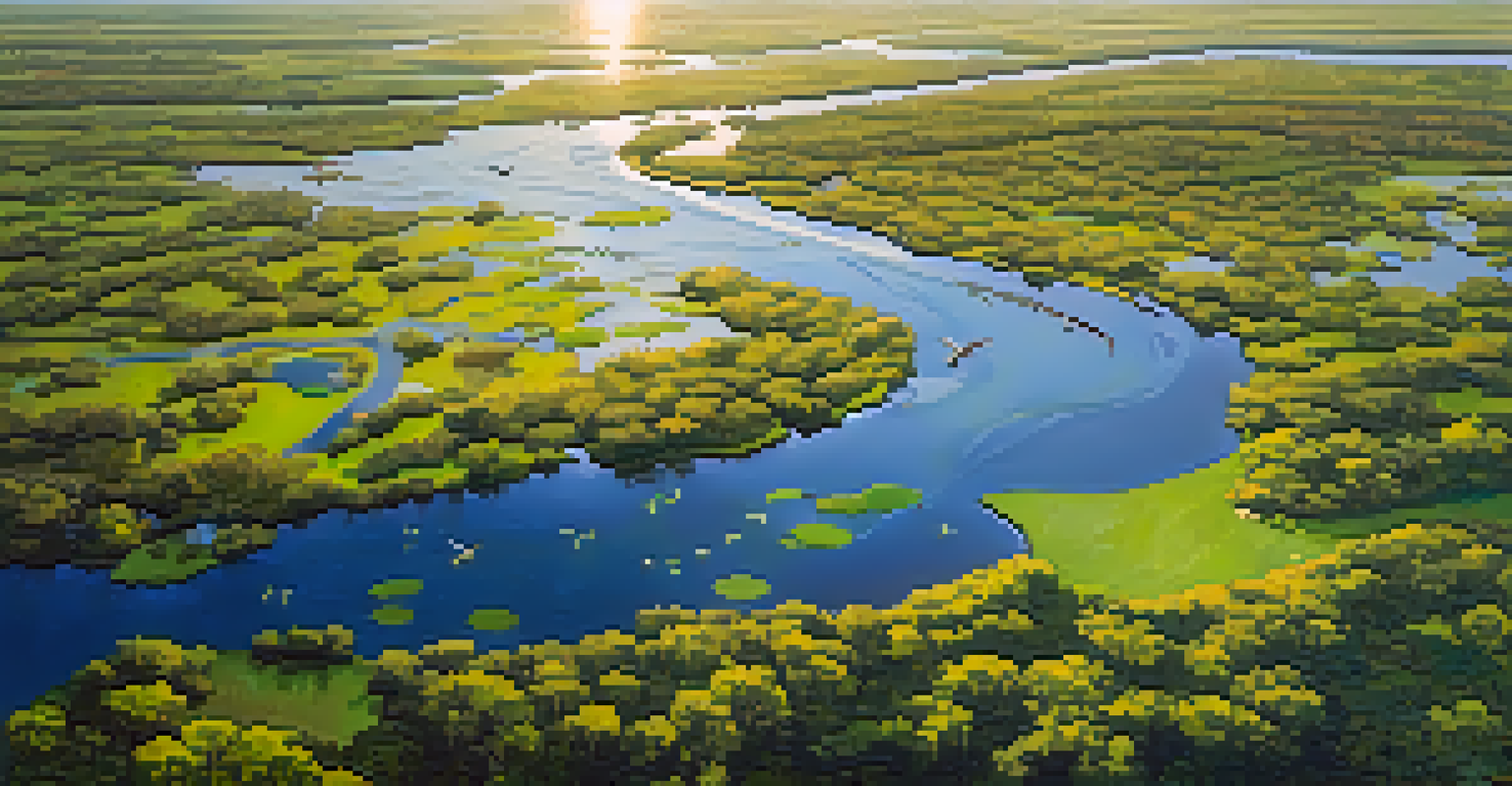Austin's River Ecosystem: Home to Unique Aquatic Wildlife

An Overview of Austin's River Ecosystem
Austin's river ecosystem is a vibrant and diverse habitat that supports a wide array of aquatic life. The city's rivers, particularly the Colorado River, provide essential resources for both wildlife and humans. These waterways not only serve as recreational spots but also play a crucial role in maintaining the ecological balance of the region.
The river is the lifeblood of the land; it connects us to our environment and sustains the diverse species that inhabit it.
The rivers are interwoven with the landscape, creating a unique environment where various species thrive. From fish to amphibians, each organism contributes to the overall health of the ecosystem. Understanding this intricate web of life helps us appreciate the importance of preserving these natural resources.
Moreover, the health of Austin's rivers directly impacts the quality of life for its residents. Clean water sources are vital for drinking, recreation, and supporting local wildlife. Therefore, protecting this ecosystem is not just about saving wildlife; it's about safeguarding our community's future.
Key Species Found in Austin's Rivers
Austin's rivers are home to a number of unique aquatic species, each playing its own role in the ecosystem. Notable residents include the Guadalupe bass, which is recognized as Texas's state fish, and various species of catfish and sunfish. These fish not only add to the biodiversity but also attract anglers and nature enthusiasts alike.

In addition to fish, the rivers support a rich variety of invertebrates, such as crayfish and freshwater mussels, which are crucial for maintaining water quality. These creatures help filter pollutants and provide food for larger animals. The presence of these species indicates a healthy aquatic environment, emphasizing the interconnectedness of all living things.
Austin's Rivers Support Biodiversity
The diverse aquatic life in Austin's rivers, including fish, invertebrates, and birds, plays a crucial role in maintaining the ecological balance of the region.
Birds, such as herons and kingfishers, also rely on the river ecosystem for food and nesting sites. Their presence reflects the richness of the habitat and serves as a reminder of the importance of preserving these natural areas. The diversity of life here is a testament to the ecological significance of Austin's rivers.
The Role of Wetlands in the Ecosystem
Wetlands play a pivotal role in Austin's river ecosystem, acting as natural filters for water. They trap sediments and pollutants before they enter the rivers, improving water quality. This process is essential for maintaining the health of aquatic habitats and supporting the wildlife that depends on them.
In nature's economy, the law of supply and demand is the law of life, and nature takes care of its own.
These areas are also crucial for flood management, absorbing excess rainwater and reducing the risk of flooding in nearby communities. By acting as buffers, wetlands protect both the ecosystem and urban areas from the impacts of heavy rainfall. This dual function makes them invaluable to the city’s infrastructure and environmental health.
Furthermore, wetlands provide critical breeding and nursery grounds for various fish and wildlife species. The shallow waters and abundant vegetation create a safe haven for young animals to grow and thrive. Preserving these wetlands is key to ensuring the continued success of Austin's river ecosystem.
Human Impact on the River Ecosystem
While Austin's rivers are home to diverse wildlife, human activities have significantly impacted their health. Urban development, pollution, and recreational activities can strain the ecosystem, leading to habitat loss and declining species populations. Understanding these impacts is vital for fostering a sustainable relationship with our natural resources.
Pollution from runoff, including fertilizers and waste, can degrade water quality, affecting both wildlife and human health. Efforts to mitigate these effects, such as implementing green infrastructure and promoting responsible waste disposal, are crucial to restoring the ecosystem. Community involvement in these initiatives can lead to significant improvements.
Wetlands Are Vital Ecosystem Filters
Wetlands in Austin serve as natural filters, improving water quality and providing essential habitats for wildlife, while also aiding in flood management.
Moreover, responsible recreation is essential for protecting the wildlife that inhabits these rivers. Educating the public about the importance of respecting natural habitats can help minimize disturbances to aquatic life. By fostering a culture of conservation, we can ensure that Austin's rivers remain vibrant and healthy for generations to come.
Conservation Efforts for Austin's Rivers
Numerous organizations and community groups are dedicated to conserving Austin's river ecosystem. These efforts include habitat restoration projects, water quality monitoring, and public education initiatives. By working together, they aim to create a more sustainable environment for both wildlife and residents.
One notable initiative is the restoration of riparian zones, which are the interfaces between land and a river. These areas are crucial for providing shelter and food for aquatic species while also stabilizing riverbanks and improving water quality. Community volunteers often participate in planting native vegetation, which enhances these vital habitats.
Additionally, educational programs help raise awareness about the importance of preserving the river ecosystem. Workshops, guided tours, and outreach efforts engage residents and encourage them to become stewards of their natural surroundings. Through these initiatives, the community can actively contribute to the health of Austin's rivers.
Recreational Activities and Their Benefits
Austin's rivers offer a plethora of recreational activities that not only enhance the community's quality of life but also foster a deeper connection to nature. Activities like kayaking, fishing, and hiking along the river trails allow residents and visitors to experience the beauty of the ecosystem firsthand. These experiences can inspire individuals to become advocates for conservation efforts.
Moreover, engaging with the river ecosystem through recreation can have mental and physical health benefits. Studies have shown that spending time in nature reduces stress and promotes overall well-being. The rivers provide an accessible escape for urban dwellers, making it essential to maintain their health and accessibility.
Community Involvement Drives Conservation
Local organizations and residents are actively engaged in conservation efforts to restore habitats and promote sustainable practices for the health of Austin's rivers.
However, it's vital for recreationalists to practice responsible habits while enjoying these activities. Adopting 'Leave No Trace' principles ensures that we minimize our impact on the environment. By being mindful of our actions, we can enjoy the river's beauty while protecting the aquatic wildlife that calls it home.
Looking Ahead: The Future of Austin's River Ecosystem
The future of Austin's river ecosystem depends on our collective efforts to protect and restore it. As urban growth continues, it's essential to prioritize sustainable development that respects natural habitats. This balance is crucial for ensuring that both people and wildlife can thrive in harmony.
Innovation in conservation practices, such as green infrastructure and sustainable landscaping, can help mitigate the impacts of urbanization. By integrating nature into our urban planning, we can support the health of the river ecosystem while enhancing the city's livability. It’s a win-win scenario for both residents and wildlife.

Ultimately, fostering a culture of conservation within the community is key to the future of Austin's rivers. Engaging citizens in conservation efforts and promoting sustainable practices can create a lasting impact. Together, we can ensure that Austin's river ecosystem remains a vibrant and essential part of our city's identity.